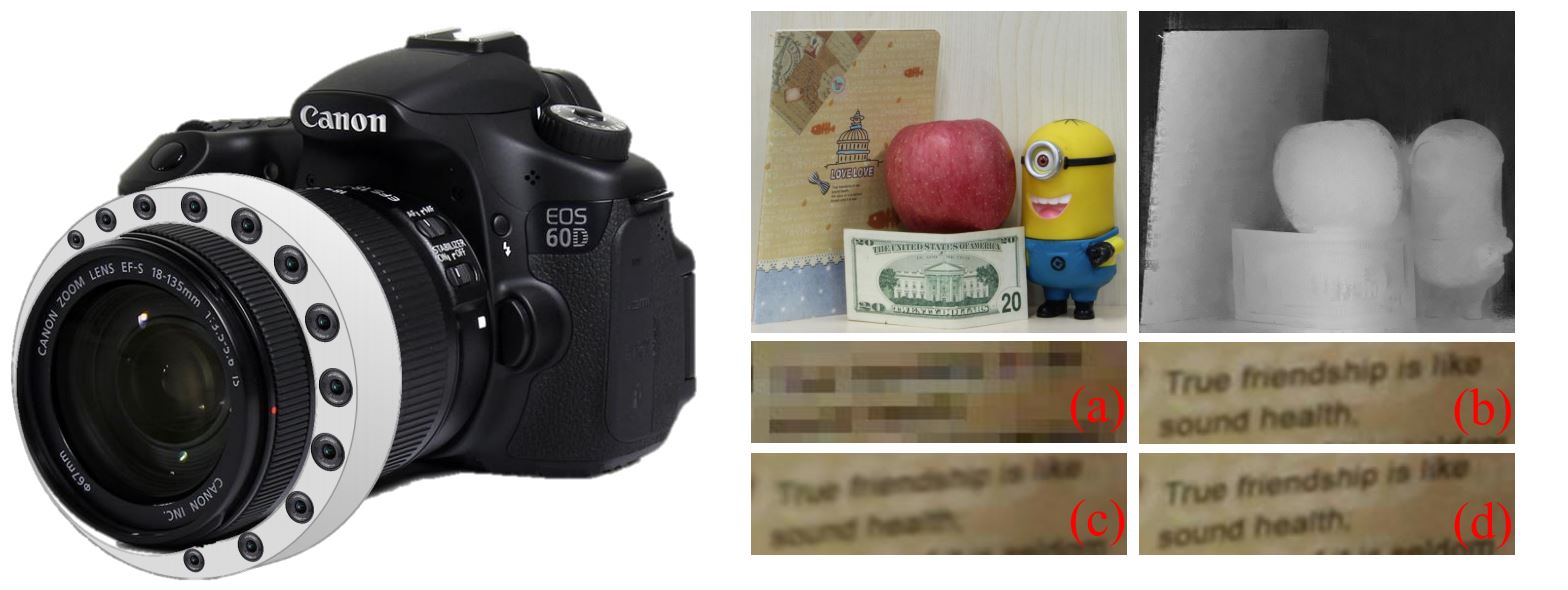IEEE Transactions on Visualization and Computer Graphics (TVCG)
The Light Field Attachment: Turning a DSLR into a Light Field Camera Using a Low Budget Camera Ring
Yuwang Wang Yebin Liu Wolfgang Heidrich Qionghai Dai
Deptartment of Automation, Tsinghua University, King Abdullah University of Science and Technology
 |
|---|
We propose a concept for a lens attachment that turns a standard DSLR camera and lens into a light field camera. Left: Conceptual design of our light field lens attachment. Right: The top left image is a scene captured using our system, and the top right image is the estimated disparity map. The bottom four images are: (a) an image patch from a side-view camera, (b) an image patch from the center-view DSLR camera, (c) the patch-based super-resolution result, and (d) the super resolution result obtained using our method.
 |
|---|
The pipeline of the proposed iPADS algorithm and dense light field synthesis. iPADS iterates between patch-based superresolution (PaSR, step 1) and depth-based synthesis (step 2, 3 and 4) for the synthesis of new images that are then updated into the patch database (step 5) for better patch-based super-resolution. The depth-based synthesis includes multiview depth estimation (step 2), depth-aided phase-based synthesis (DAPS, step 3) and optical-flow-based warping (step 4). Finally, a dense light field synthesis step is executed to render the final output using the estimated depth information.
Abstract
We propose a concept for a lens attachment that turns a standard DSLR camera and lens into a light field camera. The attachment consists of 8 low-resolution, low-quality side cameras arranged around the central high-quality SLR lens. Unlike most existing light field camera architectures, this design provides a high-quality 2D image mode, while simultaneously enabling a new high-quality light field mode with a large camera baseline but little added weight, cost, or bulk compared with the base DSLR camera.From an algorithmic point of view, the high-quality light field mode is made possible by a new light field super-resolution method that first improves the spatial resolution and image quality of the side cameras and then interpolates additional views as needed. At the heart of this process is a super-resolution method that we call iterative Patch- And Depth-based Synthesis (iPADS), which combines patch-based and depth-based synthesis in a novel fashion. Experimental results obtained for both real captured data and synthetic data confirm that our method achieves substantial improvements in super-resolution for side-view images as well as the high-quality and view-coherent rendering of dense and high-resolution light fields.
Video
Download
Citation:
Yuwang Wang, Yebin Liu, Wolfgang Heidrich, Qionghai Dai, The Light Field Attachment: Turning a DSLR into a Light Field Camera Using a Low Budget Camera Ring, IEEE Transctions on Visualization and Computer Graphics.
@article{lfattachTVCG,
author = {Wang, Yuwang and Liu, Yebin and Heidrich, Wolfgang and Dai, Qionghai },
title = The Light Field Attachment: Turning a DSLR into a Light Field Camera Using a Low Budget Camera Ring},
journal = {IEEE Transctions on Visualization and Computer Graphics},
year = {2017},
}